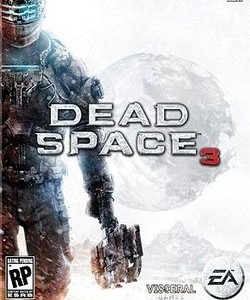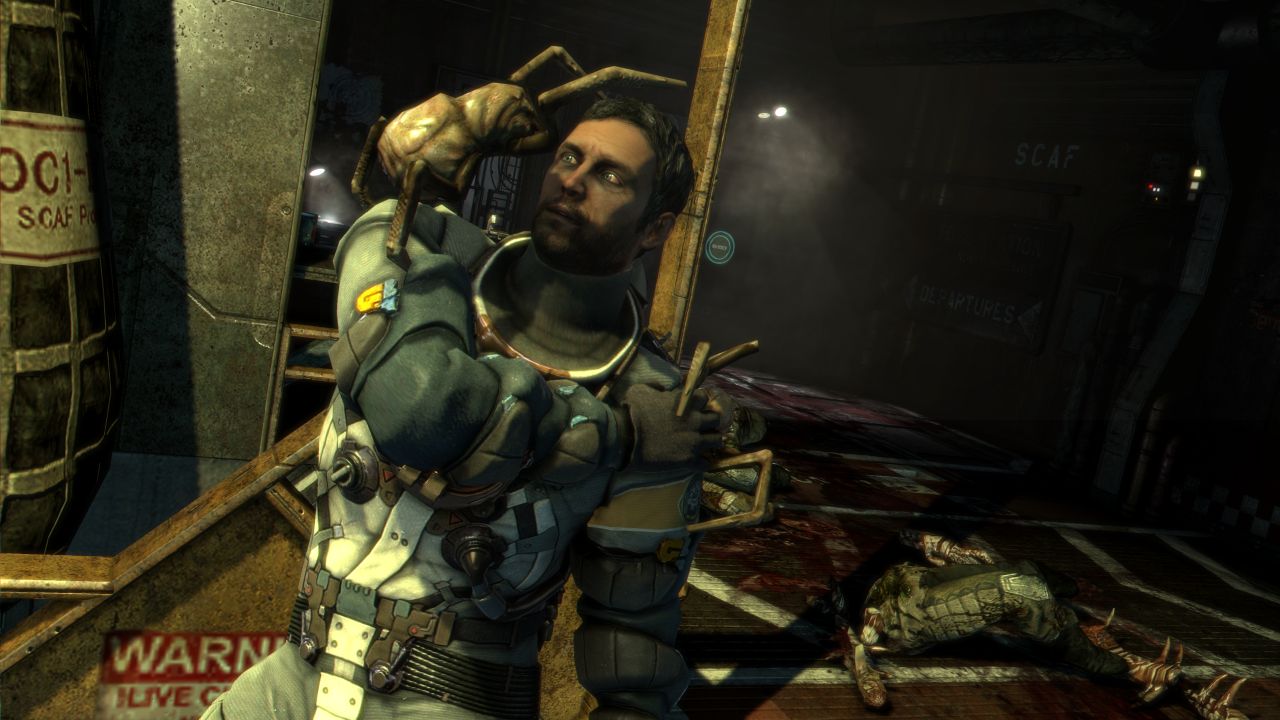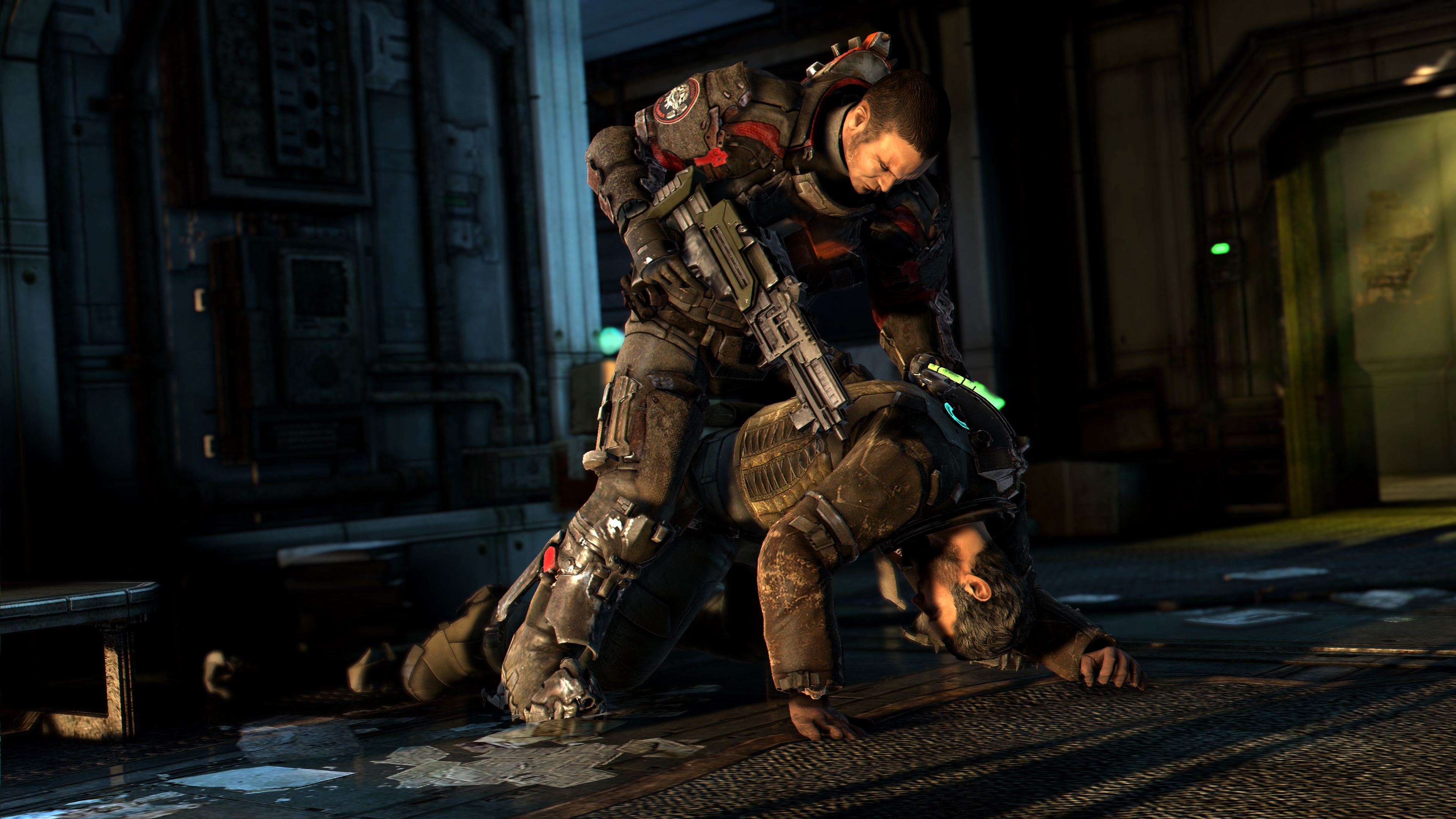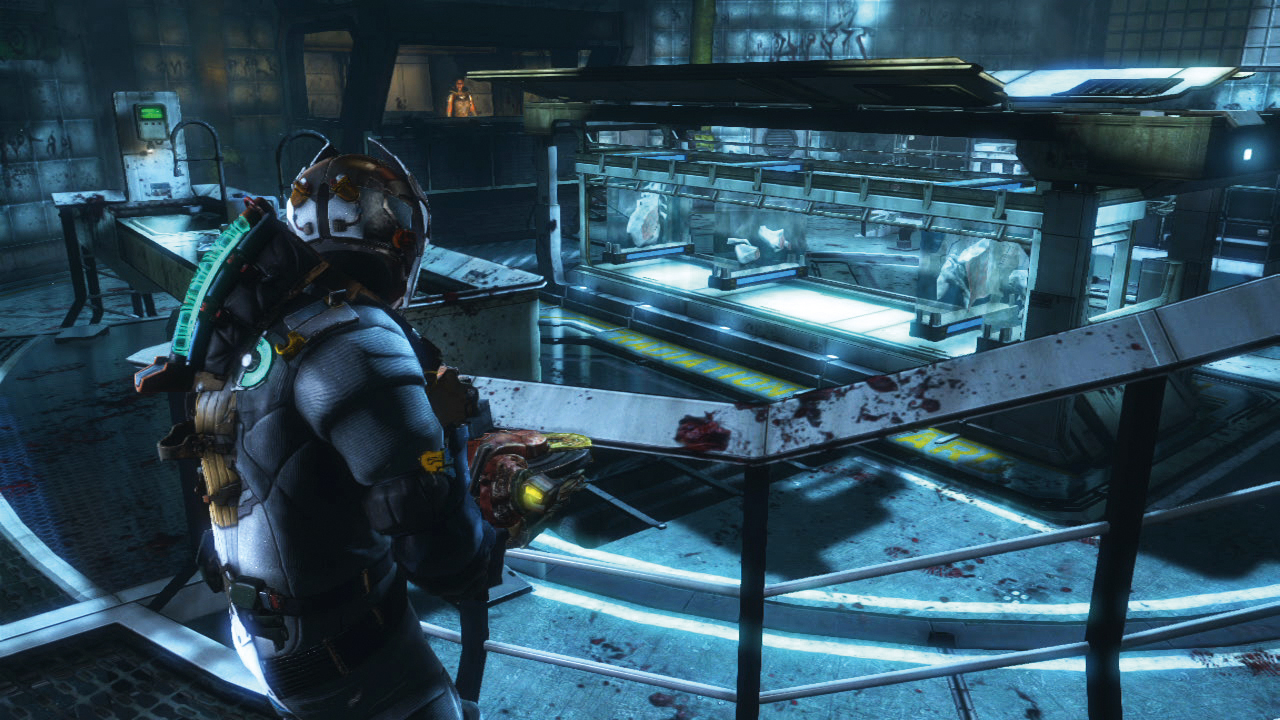Bret Robbins, the creative director for the original Dead Space game (a critically acclaimed survival horror game, now almost five years old) put it best, “The thing about doing horror, it’s kind of like doing comedy. You can’t tell a joke twice.”
Then Wright Bagwell, the creative director for Dead Space 2 (a critically acclaimed sequel, now two years old) inherited that unenviable, inevitable assignment – to write more jokes that sound like the first ones but aren’t and are, in practice, funnier. Bagwell explained his position, “We just can’t throw you into another haunted house, change the house and change the monsters, and expect it to feel like a compelling story.” I’m sensing a theme, here.
So Bagwell and the team at Visceral Games cranked up the violent hallucinations, gave Isaac Clarke (series protagonist and player-character) a speaking part, threw him around some derailed trains, and sent Isaac back to the USG Ishimura (the first game’s haunted house) for only like a half hour – I suspect they couldn’t resist. Scripted action sequences became the new punch-line to the first game’s unrelenting series of oppressive, tense corridors. Dead Space 2 relented on the corridors, shoved some needles into some eyeballs, and tacked on a forgettable multiplayer bit that was, with any luck, forgotten. Judging by the appreciably high average review metric, Visceral had towed the line between reinvention and replication rather well, and set themselves up for an even more difficult task in closing out the story arc with a third game.
I’ll preface any discussion on the relative subtleties of Dead Space 3 by saying that it’s a beautifully crafted, masterfully paced, well-balanced sci-fi shooter that capitalizes on its deep lore and above-average budget to pull off some cool set piece moments while maintaining a seamless presentation that appears almost effortless. It checks off all the AAA boxes and does it with character, which isn’t easy. Now, some opinions:
AVP: Alien vs. Predator treads similar ground in the world of film, and acts as an odd analogy for Dead Space 3 relative to its series. Like any gripping horror, there’s a mystery to the terrifying, sometimes supernatural agent, and these entries pull the curtain back on the big questions. Visceral’s motivation, I imagine, comes from saturation in the sci-fi universe, and a desire to explore its components. I mean, if an artist lived and breathed necromorphs and markers for five years, with content spanning games, movies, novels, and comics, and you never once got to explain where it all came from or why, he or she would be bursting to tell someone. It’d be like making three Lord of the Rings movies without making The Hobbit – the background piece is an eventual given.
Well, according to Ben Wanat, creative director for Dead Space 3 (note that we’re on our third creative director for the trilogy), the folks at Visceral felt that exact burden. “I think it’s just really important that we deliver a solid understanding of what it was [the players] been through in the last two games,” said Wanat, “and give them a foundation of where it could go in the future.” Note that these ideas informed early, formative discussions about the direction of Dead Space 3. I know that because the game’s punch-line isn’t tense survival scenarios, and it isn’t some high-octane mind quest. It’s a story about answers, about revealing the premise behind what’s passed for the sake of understanding.
To jump right into an example: The first Dead Space ended with a mano-y-gargantuo struggle (in the way that video games have done for some time), the opponent a many-tentacled slug giant with tender, glowing flesh pods. Midway through one of the chapters in Dead Space 3, while repelling religious nut-case gunfire, a similar slug giant flops onto an ice shelf and initiates a similar battle with glowing flesh pods and tentacle dodging. However, Dead Space 3’s version takes Isaac into the literal bowels of this creature where he shoots more glowing flesh pods and is vomited out. Another mission in Dead Space 3 calls for Isaac to descend into the carcass of a long-dead slug giant to shoot at other flesh pods in hopes of generating a biological radio signal.
From the development perspective, Dead Space 3’s slug battle comes across as an intentional decision to reanimate and dissect a moment from a previous game, thereby generating a narrative and gameplay shout-out to the series’ roots and the series’ evolution from its humble beginnings, relatively speaking. “There’s more to come!” I can hear Wanat shouting above the deafening, atonal horns. “If you liked that, just wait until you see this.”
If I forget the development perspective for a minute and step into the Dead Space fiction to interpret these slug-human interactions, I’d conclude that Isaac’s corpse tampering (something he’s rather familiar with by 3) is a scientific answer to a thin premise. It hints at the top-level question of motive that confounds my buy-in with Isaac’s journey to and into Tau Volantis, the secret-laden ice planet, that question being, “Why?”
Isaac’s trajectory to the center of the frozen rock starts simply enough. The ol’ ex has gone and lost herself in zombie space orbiting the ice rock and needs rescuing. Isaac may be a drunk has-been engineer, but by-golly he’ll save the girl! So he spends some time finding her in the ruins of a 200 year-old derelict space craft, and pieces together a working vessel. Awesome, let’s bounce.
NOPE. Sorry gamer, but your instinct for survival is misplaced. See, where previous games taught you to do whatever it takes to survive, even careening through some carnival ride of a space station to stab yourself in the eye to become sane again and break a statue, not dying is central to that velocity. Dead Space 3, now tired of the survival instinct, its developers desperate to drop some serious sci-fi knowledge bombs, opts for the “we can save the universe” approach, which in the context of its fiction implies a journey of discovery as well. In order to destroy the marker signal and end the space zombie apocalypse, Isaac is compelled to find the source.
Survival, I’d argue, is a more universal, instinctual compulsion than understanding. That’s not to say that unraveling the mysteries of a deep and complex sci-fi universe doesn’t fascinate me (I read Martyr and Salvage and watched Aftermath and Downfall). Rather, I just don’t find this joke as funny as the first. It’s a matter of opinion and degrees, and one that has implications for the game’s core systems as well as the adorning narrative. If the goal is to scare (but not scare away), then the intention is a tricky balance of vulnerability and growth. If the goal is to educate, then the intention is to empower.
One of the more obvious ways this plays out in Dead Space 3 is the ample availability of ammunition. Survival in a shooter hinges on the usefulness of weaponry which can be throttled or enhanced in a myriad of ways. The first Dead Space chose to bottleneck that tension at ammo supply. The player had a variety of make-shift space guns but had to dismember necromorphs with precision to preserve the limited amount of stomp-spawned rounds. Then, in the evolution to Dead Space 2, the point of entry on empowerment shifted. Wright Bagwell justifies the turn:
“What we found is that as long as we focused on making the game really atmospheric and putting you in freaky situations and getting the timing of everything right, you didn’t really have to disempower the player that much in order to scare him.”
I’d argue that Bagwell’s theory holds water given that the empowerment pendulum hasn’t swung all the way over to superhero status. As long as the environment, atmosphere, or enemies still pose a threat to the player’s contiguous play, then freaky situations and good timing can do the trick. Dead Space 3, however, finds Isaac with the beefiest arsenal in the series and a slick, monetized system for enbeefening. Even without spending a dime on gun upgrades, I was able to coast through hordes of Wasters, Leapers, Stalkers, and Slashers without ever resorting to flying fisticuffs thanks to the unified ammo type and other returning abilities like stasis and kinesis. Granted, I played Dead Space 3 on Normal, and the higher difficulties promise less beef and more terror. But the concept behind the payment Bench implies an upped arsenal and a focus on gleeful spilling of necrosed blood.
The feeders present a few short segments of counter argument, giving the player the option to try sneaking past the photophobic cannibals rather than take a swarm of them head on. The basement of an old mining station turned into the game’s most terrifying segment because of their skittish movement, ghastly skeletal frames, and piercing screeches. That and similar dens were the ones I most dreaded, and most remember. I went in firing, and came out stomping.
Sound design in Dead Space 3 also holds up its end of the horror bargain, delivering every guttural, bone-crunching incision to the tune of my teeth-sucking squeals. Even here, though, I found that the ascending strings and horns would often betray an otherwise surprise enemy encounter, breaking the tension of a music-less environment. If only there was some succinct phrase that could express the idea of a soundless, airless void while hearkening to the sci-fi setting of Isaac’s expedition, the necromorphic properties of his enemies, and the horrific majesty of exploring the merciless unknown. IF ONLY.
Dead Space 3’s pro-set piece slant isn’t a problem or incorrect, but it is a disappointment for gamers like me who prefer our interstellar intrigue quieter, and mental. The roller coaster from the moon to the abandoned space stations to the caverns of Tau Volantis didn’t hold the kind of playful surprise that the first game cornered. It’d been done, and there was new ground that was begging to be covered. An intense shuttle sequence down to the planet surface. Necromorphs with guns. Rappelling. Optional missions with genuinely intriguing character vignettes. And the elephant, drop-in drop-out co-op.
To put it all into context, Visceral returned to the conceit of the mystery graveyard and turned up the “why this matters” dial with the necromorph origin story played in reverse. Isaac starts by exploring the ruins of Dr. Serrano’s 200 year-old attempt at the same venture, explained mostly in audio logs or conversation, and ends with an even older, more unexpected discovery. The story arc is the slow, deliberate opening of a tomb. Unlike the previous games, there’s no chance of finding survivors, and few instances of dementia. This is Dead Space History 103.
The zombies have to shake off some of the years caked on their exposed membranes. Isaac even dons a few age-battered suits in his attempt to unearth answers. His partner, Carver, while moving the series forward in its feature-set, regresses to marker hallucinations in specific, co-op only, asynchronous side missions. With the RPG elements built into gun customization and RIG upgrades (MORE TUNGSTEN), these and other side missions become a form of grinding marked by escalating bouts of horde mode combat and quick character stories. As a side note, the character stories were my personal highlights of Dead Space 3, particularly the cabin-boy-gone-slasher subplot.
And it’s here, in the surplus ammo stash of another side mission, that I hear Visceral’s message most clearly. “Boo!” Ok, that, and then, “Hey Dan, you’re weird.”
… which is really an oblique way of saying that Visceral appreciates that fans of the original Dead Space, like me, are in the minority in terms of taste. Who else would continue to slurp up the kind of sensory punishment that made the first Dead Space a wide-market cult hit? Yes, I hear the incongruity, too. But no, I don’t suppose I’m right about this. That doesn’t make the insult sting any less.
Hypothetically, if Dead Space 3 were a much scarier repackaging of the first game, then it would run the risk of retracing its steps and losing me altogether. In its current form, the trilogy ends on a high-energy note. Maybe it’s not the choice I would have made, but it provides a startling premise for the events of the first two games (and the expanded universe) and pulls it together with enough point-and-shoot variety that I was never disinterested. Certainly Norton and the other tack-on characters could have mustered a bit more nuance and believability in their roles. And what I would’ve given for an empty hallway, a suspicious gurgle, and an upside-down tentacle shootout! That’s Dead Space to me. I am not Dead Space.





















